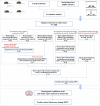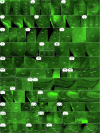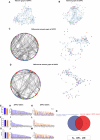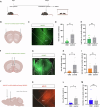Differential brain activation and network connectivity in social interactions presence and absence of physical contact
- PMID: 40603622
- PMCID: PMC12222910
- DOI: 10.1038/s42003-025-08417-w
Differential brain activation and network connectivity in social interactions presence and absence of physical contact
Abstract
Comparative studies of social interaction in the presence of physical contact (SIPPC) and social interaction in absence of physical contact (SIAPC) enhance our understanding of the neurophysiological mechanisms underlying these activities. We analyzed comparatively the effects of SIPPC and SIAPC on c-fos expression across 100 brain regions in mice, and found that SIPPC activated a broader range of brain regions, particularly those associated with emotion and reward. Subsequent observations of brain activity coordination and network construction highlighted the critical roles of the infralimbic cortex (IL), lateral septal nucleus intermediate part (LSI), and agranular insular cortex ventral part (AIV) in SIPPC. Additionally, we demonstrated through chemogenetic techniques that inhibiting the activity of AIV, LSI brain regions, or AIV-LSI circuit significantly reduces the tactile contact behavior of mice during SIPPC. To sum up, our findings elucidate the similarities and differences in brain activity and network connectivity between SIPPC and SIAPC, while identifying specific brain regions and neural circuit that may mediate tactile contact in social interaction.
© 2025. The Author(s).
Conflict of interest statement
Competing interests: The authors declare no competing interests. Ethics: All animal procedures were approved by the Ethics Committee of Harbin Medical University (approval number-HMUIRB2023039).
Figures









Similar articles
-
Peripuberty Is a Sensitive Period for Prefrontal Parvalbumin Interneuron Activity to Impact Adult Cognitive Flexibility.Dev Neurosci. 2025;47(2):127-138. doi: 10.1159/000539584. Epub 2024 Jun 3. Dev Neurosci. 2025. PMID: 38830346 Free PMC article.
-
Oxytocin neurons in the paraventricular nucleus and fear empathy among male mice.J Psychiatry Neurosci. 2024 May 30;49(3):E192-E207. doi: 10.1503/jpn.230125. Print 2024 May-Jun. J Psychiatry Neurosci. 2024. PMID: 38816029 Free PMC article.
-
Mapping Brain-Wide Neural Activity of Murine Attentional Processing in the Five-Choice Serial Reaction Time Task.Neurosci Bull. 2025 May;41(5):741-758. doi: 10.1007/s12264-025-01380-w. Epub 2025 Mar 22. Neurosci Bull. 2025. PMID: 40121342
-
Factors that influence parents' and informal caregivers' views and practices regarding routine childhood vaccination: a qualitative evidence synthesis.Cochrane Database Syst Rev. 2021 Oct 27;10(10):CD013265. doi: 10.1002/14651858.CD013265.pub2. Cochrane Database Syst Rev. 2021. PMID: 34706066 Free PMC article.
-
Computer and mobile technology interventions for self-management in chronic obstructive pulmonary disease.Cochrane Database Syst Rev. 2017 May 23;5(5):CD011425. doi: 10.1002/14651858.CD011425.pub2. Cochrane Database Syst Rev. 2017. PMID: 28535331 Free PMC article.
References
-
- O Miguel, H. et al. Touch processing and social behavior in ASD. Zenodo10.1007/s10803-017-3163-8 (2017). - PubMed
-
- Mello, M., Fusaro, M., Aglioti, S. M. & Minio-Paluello, I. Exploring social touch in autistic and non-autistic adults via a self-report body-painting task: the role of sex, social context and body area. Zenodo10.1177/13623613231218314 (2024). - PubMed
-
- Ma, Y. K. et al. Lack of social touch alters anxiety-like and social behaviors in male mice. Zenodo10.1080/10253890.2022.2047174 (2022). - PubMed
MeSH terms
Substances
Grants and funding
LinkOut - more resources
Full Text Sources

